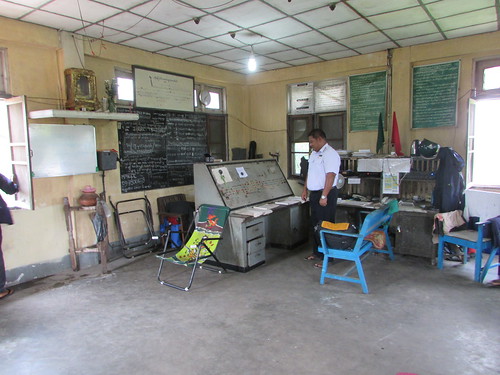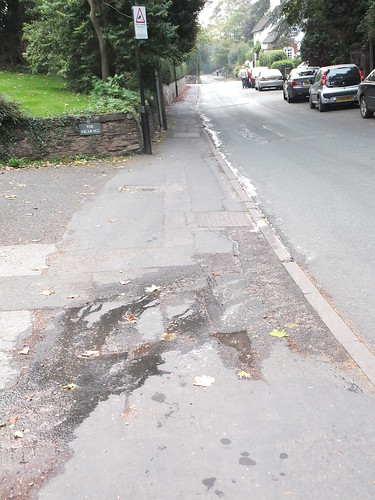This post is one of what appears to be becoming a series about infrastructure and 'the built environment' in the United Kingdom. The first, Infrastructure Problems, discussed how services are distributed in this country, touching on some of the problems which can arise. The second post, Infrastructure Problems (2), rambled on about road repairs and potholes before returning to the theme of water leaks and other failures.
This updare talks about a (fortunately fairly minor) water leak, before turning to temporary traffic lights.
Another Water Leak
In May 2020, I found a water authority surveyor already at the site of a leaking buried water main in Sandy Lane. Having already marked the offending area with blue spray paint, he was using his mobile telephone to summon a repair team. A neat gash, a few inches long, had appeared in the road surface and water was bubbling out and running downhill. It wasn't a very impressive leak, but I took a couple of pictures.
Water main problems (Brewood Village)
The picture immediately above also shows a Fire Hydrant connection. Raising the hinged lid of the cast box at the bottom of the picture gives access to the water main for use by the water authority and firefighters. The rather battered, yellow-painted concrete stump adjacent carries a cast plate with a large 'H' (for hydrant) and a cast figure which I think reads '3' indicating a 3-inch diameter main.
Nowadays, Fire and Rescue Services makes extensive use of computerisation and the picture below shows the type of map available in the cab of fire appliances to facilitate locating nearby Hydrants. I took this picture when the local fire appliance was on display during the Brewood Garden Party in 2019 (there's a post about the Garden Party here with a link to pictures of the fire appliance). The hydrant shown in the picture above can just be seen on the left of the map view below as a yellow square with an 'H'. There's also '75' (sideways) which I presume means that the fire service have metricated the '3 inches' to millimetres.
Staffordshire Fire and Rescue Service makes extensive use of computerisation. This view shows the 'Sat-Nav' function available on the display in the vehicle cab.
Temporary Traffic Control
When I was young, filamentary lamps in the signal head normally required a portable generator to provide sufficient electrical power and the control of the sequencing was purely determined by timers. Cables had to be connected between the traffic signals, allowing light sequences to be controlled.
In more modern equipment, the use of high efficiency Light Emitting Diode (LED) lamps have reduced power demand sufficiently to make rechargeable batteries a viable power source. Additionally, microwave detectors incorporated into the signal heads directed towards oncoming traffic allowing detection of waiting vehicles and dynamic adjustment of light changes to suit actual traffic flows. Finally, interconnected cables are eliminated by the use of a radio data link between traffic signals.
The simple example illustrated below shows one of two traffic signals deployed in Sandy Lane in 2018 during excavations to connect two new houses to buried gas, electricity, water and drainage services. The first picture shows the rear of the traffic signal at the upper end of the narrowed carriageway. Batteries in the base unit power the unit and the electronic controller is in the control box mounted on the mast supporting the signal head. It shows a TR 2502A-AP16 made by Pike Signals and on hire from A-Star Traffic Management,
Temporary Traffic Signal during connection of services to New Houses in Sandy Lane.
Control Box showing indications on electronic controller
This is a very simple example - the Pike Signals website illustrates their 'Evo' range suitable for temporary multiple road junctions incorporating pedestrian crossings.
Pictures around Brewood Village
The following album includes some examples of local services infrastructure. Pictures may be viewed in various sizes or downloaded for non-commercial use.
The following album includes some examples of local services infrastructure. Pictures may be viewed in various sizes or downloaded for non-commercial use.




























